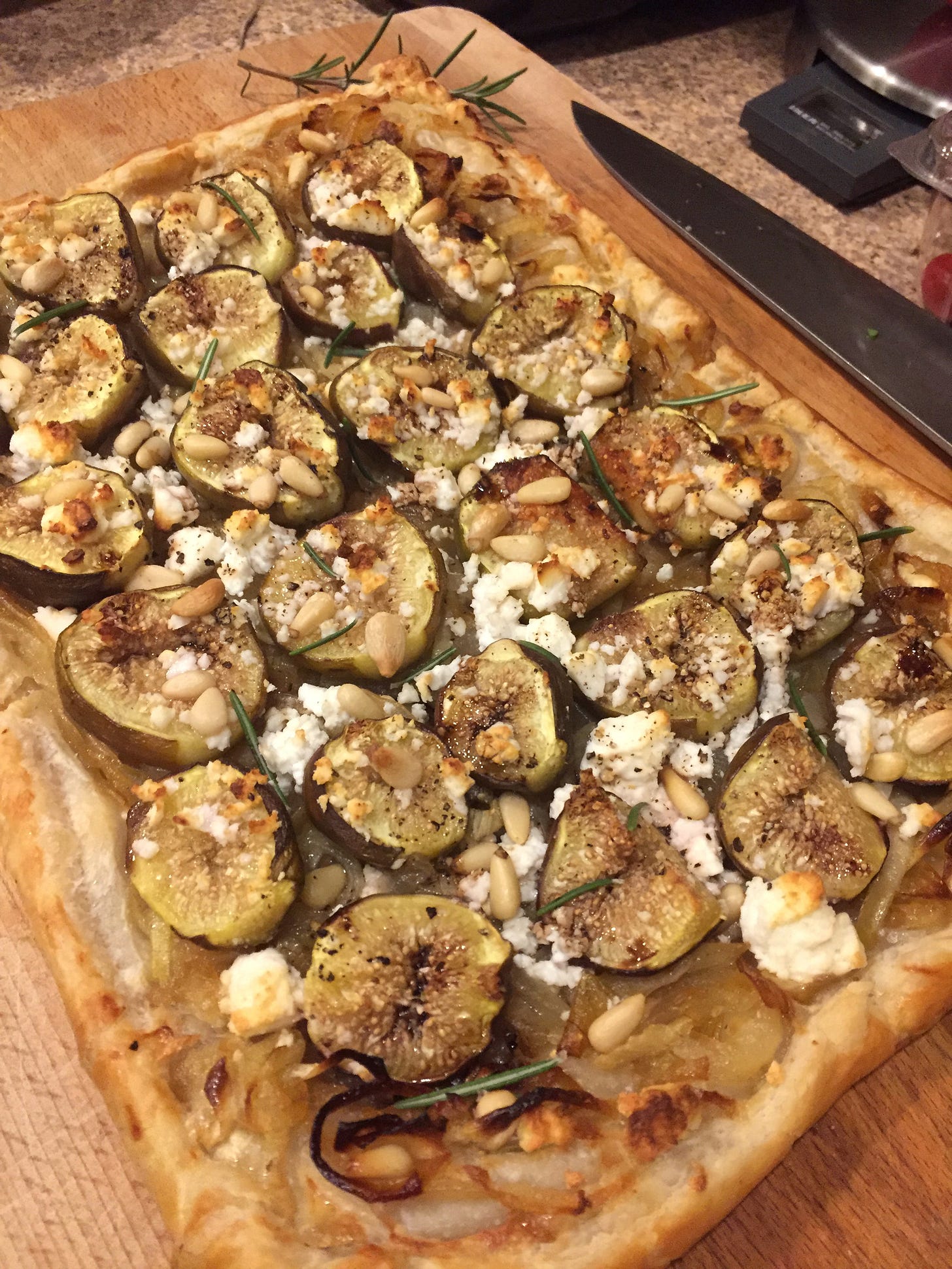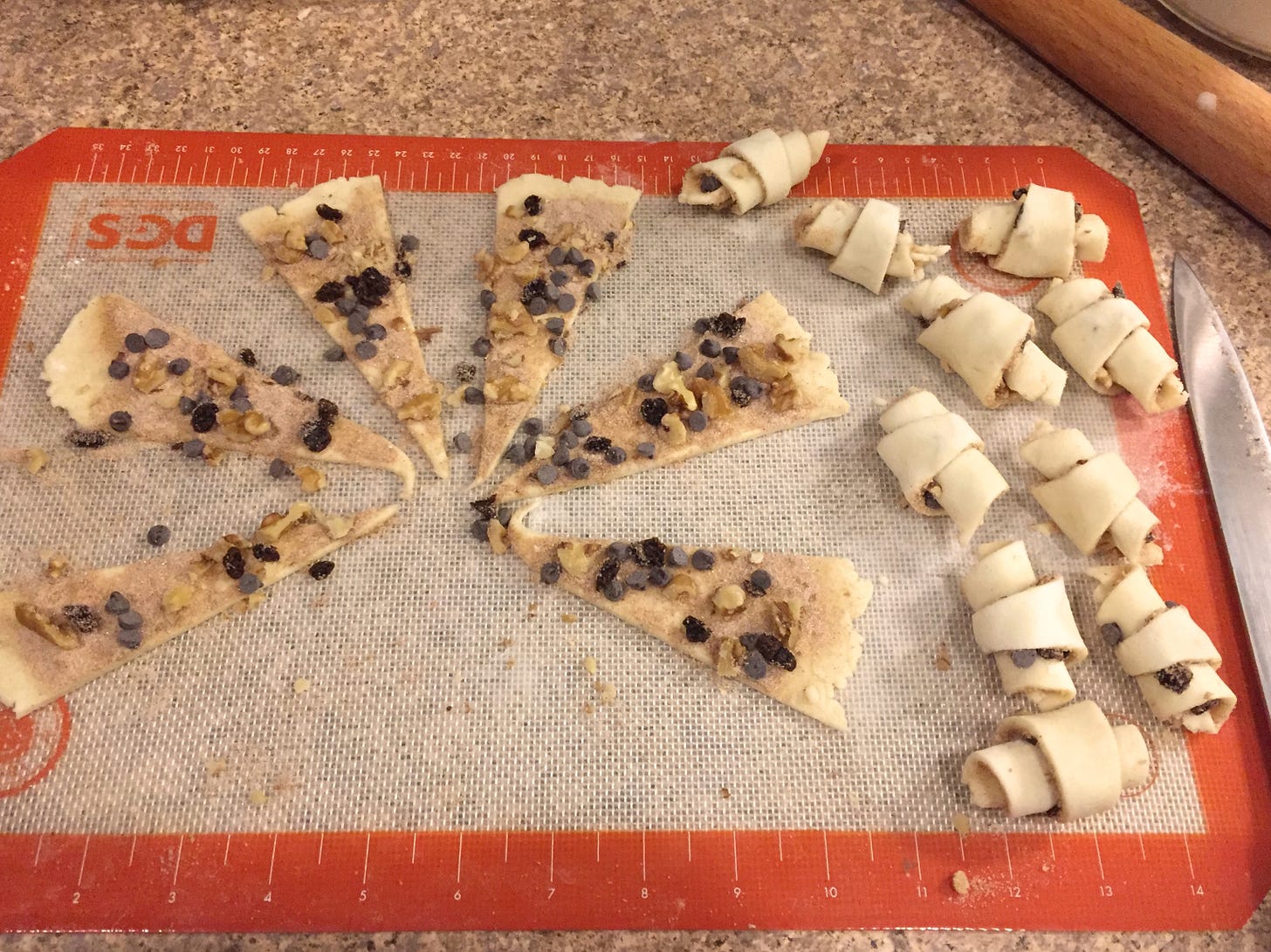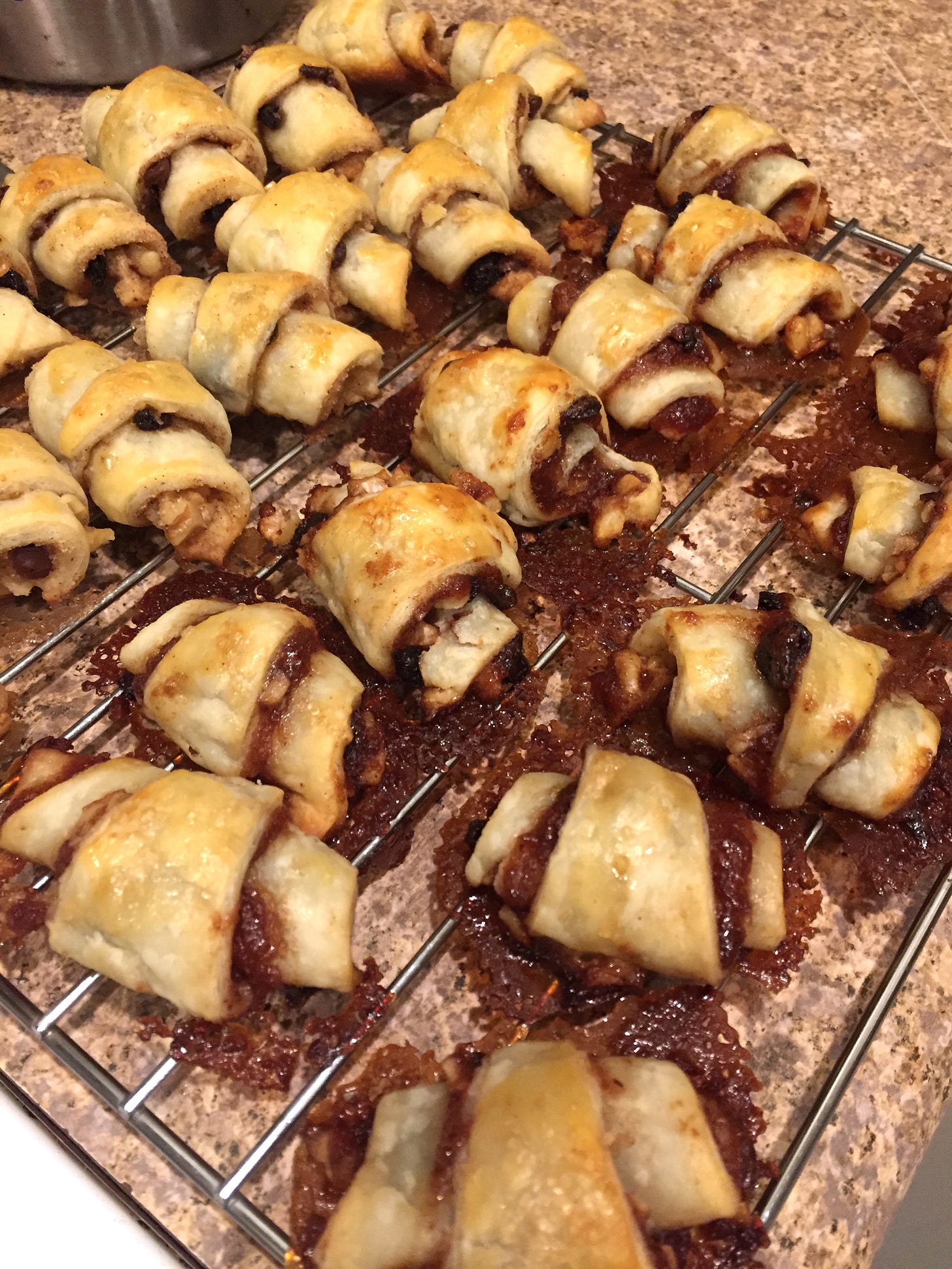Hello from a world that’s feeling a tiny bit less dark. I hope all my American friends had a wonderful weekend— I heard liquor stores in DC sold more champagne on Saturday than the last two New Year’s Eves combined! Seeing the videos of masked people cheering and dancing in the streets of New York, Chicago, LA, Atlanta, Philadelphia warmed my heart. We opened a bottle of brüt from Stoneboat, an Oliver winery I love, and made some very tasty French 75s with some gin from Gibsons and lemons leftover from our limoncello adventure, and toasted our friends on our weekly online games night. We all know this won’t magically fix everything that is broken, and there is so much work to be done, but you deserve to take a rest and celebrate this victory (not to mention being able to finally turn off CNN after four days). Cheers.
While doing some yard work over the weekend, we discovered that against all odds, our backyard fig tree that sat with stubbornly green fruit from August to October, now has a handful of ripe, purple figs! I didn’t want to just resign myself to making more jam, so I looked up some possibilities for savoury fig recipes. We picked a cereal bowl full of the darkest-looking ones and made a version of this fig and caramelized onion tart, with goat feta instead of stilton (I’m not much of a blue cheese fan, while Jeff is but his body is not). It was easy to make, provided you remember to start caramelizing the onions in time— the recipe says 30-40 minutes but it took almost an hour for me. They have a sprig of rosemary cooked along with them to infuse them with a woody flavour that’s pure fall, and complements the figs and cheese nicely.
It was my first time using DuFour puff pastry, which comes highly recommended from various recipe bloggers and food writers. This is an all-butter dough so it’s more expensive; my usual grocery store choice, Tenderflake, is made with vegetable oil and is about half the price. Also unlike Tenderflake, it is already rolled out, but maybe mine was sitting in the freezer too long, because the edges were dry and there were tears at some of the creases when I unfolded it. Overall I’m not sure the butter flavour makes up for the price difference and the fiddly-ness of trying to unfold it without wrecking it. Plus, rolling out dough is kind of fun?
I was really happy with how the tart came out though. It was a lovely mix of flavours and textures: crisp pastry, sweet onions, tangy cheese, toasty pine nuts, fragrant rosemary needles, and of course the soft figs with their crunchy seeds. Instead of honey like in the recipe, I finished it off with a bit of aged balsamic vinegar, since goat cheese isn’t as sour-tasting as a blue cheese, and it worked perfectly. I’ve made a few different puff pastry tarts and they always seem to have similar elements: a base, a feature fruit or vegetable, a complementary cheese, and some garnishes for flavour and texture like herbs, nuts, breadcrumbs, or a drizzled sauce. I think you could follow this process and make something great out of just about any piece of produce you want to showcase, so I’ll try to keep this in mind for deep winter, when I’m wondering what to do with my fifth week in a row of beets and mushrooms in my produce bin.
Monday was a long work day and because I’m a nice person, I also picked up Jeff from work so he didn’t have to walk from the seabus in the rain, so I was thankful my meal plan included a trusty standby: fried rice. It’s arguably the best way to use turn a bunch of assorted fridge garbage into a delicious, satisfying meal (other contenders: pizza, soup, pasta) and doesn’t take long to make, assuming you have cooked rice in the fridge or freezer. I used to not make it much because I just wasn’t very good at it, but at the beginning of the pandemic I finally pinned down my process and my sauce contents. The key to the order for me is:
egg (quickly cook like an omelette, remove and set aside)
meat or tofu (for tofu, remove and set aside so the edges stay crisp)
veggies
garlic/ginger/green onion
anything frozen, like peas or corn
rice
sauce (my go-to is a few tablespoons of soy sauce, some gochujang or sriracha, a bit of rice vinegar or mirin, and sesame oil)
re-add egg and tofu, as well any aromatic herbs or nuts/other extras
This way the egg doesn’t overcook, the garlic won’t burn, the rice gets browned, and everything else ends up where it needs to be. I was too lazy to do tofu this time, so I added some Gardein ground round with my frozen peas, and my veggies were shiitakes, broccoli, and some carrots from the garden. I also added some peanuts, and a little bit of basil on top. Filling, tasty, and the whole thing takes about 20-25 minutes depending on how fast you are at chopping veggies, and if you’re doing meat or tofu as well. Sorry if this all sounds like a recipe blog for busy moms, but I think it’s important to have things in your repertoire that are easy and fast but not disappointing to eat… and so that you all know I’m not out here cooking five-star meals every work night.
With an unexpected stat holiday in the middle of the week, I took on a baking project to avoid doing any of the things I actually needed to get done, and made apple butter rugelach! I tried rugelach for the first time at Siegel’s Bagels in the mid-2000s, when I worked at the dry cleaner next door. I would go there for coffee and a bagel most mornings and after a few weeks one of the staff who recognized me said with a wink, “I threw a little something extra in there for you.” Inside the paper bag he handed me were two tiny pastries, one chocolate walnut and one apricot jam, and they were divine. On payday I’d often buy a dozen and take them home to share with my roommates (but not before making sure I got to eat one of all the flavours). Jewish bakeries aren’t too common in the Lower Mainland, and I don’t get out to Kitsilano much these days, but I think about those sweet little treats all the time.
I found the NYT recipe while looking for things to do with my homemade apple butter, but the Smitten Kitchen recipe is similar (it makes just over a dozen more cookies) and provides lots of variations for fillings and how to cut the dough. I used the dough method from the NYT recipe simply because that shape is the one in my memory from Siegel’s. The dough was pretty sticky because of the cream cheese, so I floured a couple of silpats to roll them out on so I could transfer to the fridge if it got too soft. I wanted to use up the jar of apple butter in the fridge but not open a new one, so I made the other half with chocolate and walnut instead (plus, variety is the spice of life or whatever).
I will admit the cream cheese I used was past its prime, but I tasted it before making the dough and nothing horrible happened, and neither did the rugelach come out terrible because of it (at the time of writing this, they’ve been out of the oven for an hour and I’ve already eaten three). The apple butter filling did ooze everywhere, but maybe that’s to be expected— it created a delicious apple-y caramel on the bottom, so, bonus. The pastry edges are crispy and the insides are soft and sweet, with chewy bits of dried currant and crunchy walnuts… just delightful. I might make these again at Christmastime, maybe a butter tart-inspired filling? In the meantime please come knock on my door if you want one or two, and save me from eating all thirty of these in two days.
Media:
I read a great piece by Joanna Fuertes for Vittles, exploring “The Bourdainification of Food Travel”. It’s strange to think about travel when it currently seems like a distant past memory. But I, like many of you probably, enjoy watching Parts Unknown and Anthony Bourdain’s gruff charm as he visits various places, exploring local favourites, hole-in-the-wall eateries, dive bars, food carts, and residents’ kitchens. However there is an uneasiness about it too, as we (the travellers), in our search for “authenticity”, make something that was not necessarily created for us about ourselves. I think Bourdain overall did a good job of treating staff and locals with respect, honouring a place’s customs, and being willing to eat or drink just about anything. But in doing so, he inadvertently encouraged millions of viewers to treat food tourism as their own white whale, some pinnacle of a unique, authentic experience of everything a place has to offer.
The author speaks with several people who work in food tourism and believe people’s experiences can be respectful and achievable, so long as their expectations are realistic. You cannot expect food to always be cheap simply because you are not in North America or Western Europe. You cannot expect a food cart to have tables and chairs, or a bathroom. You cannot expect to go to a bar that is populated only by locals when you yourself are not a local.
“Put simply, the search for the authentic as a tourist is an oxymoron. You may well be able to get a few atmospheric Instagram shots of dimly-lit diners and plastic cutlery but to find the ‘real deal’ requires an amount of time, care and rejection of your creature comforts that is incongruous to tourism.”
If we, as the kind of tourists who think of ourselves as relaxed, respectful, and open-minded compared to, for example, a midwesterner who orders a steak at a restaurant in Puerto Rico known for its traditional mofongo or someone who snaps their fingers at a waiter in Mexico, we need to be open-minded about more than just what we eat when we are travelling. We need to think about how our experiences can affect the places we are visiting, about the class structures that made, say, that plate of som tam possible. We need to treat food in other places as the joy that it is, and not an attempt to distill an entire culture into a few restaurant meals. As one food writer and guide company founder from Buenos Aires puts it:
“The best travel comes when... you’re open enough to explore a place for what it is rather than what you expect.”
Thanks for reading— if you enjoyed this newsletter, please share it with someone new! And now: when bilingual packaging attacks.








